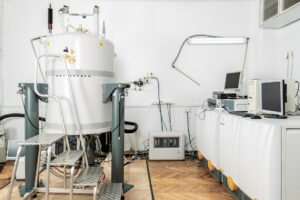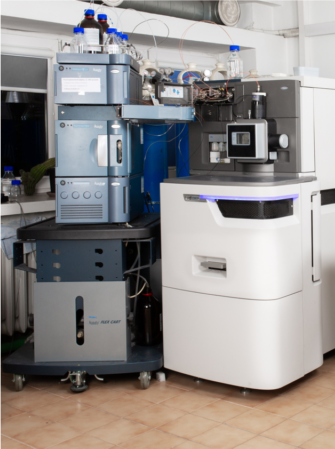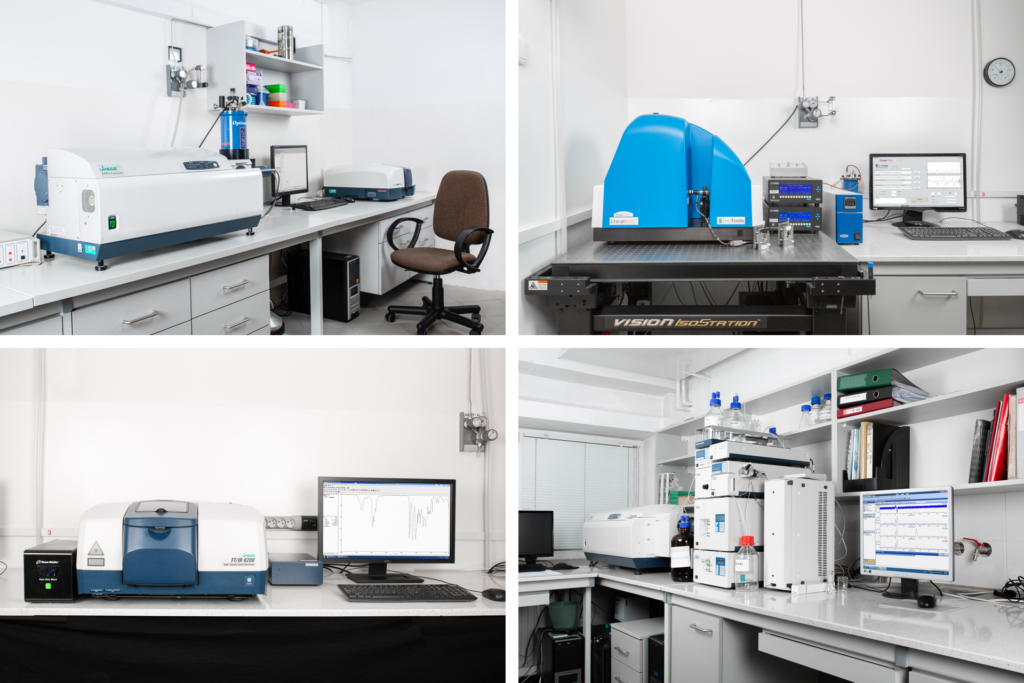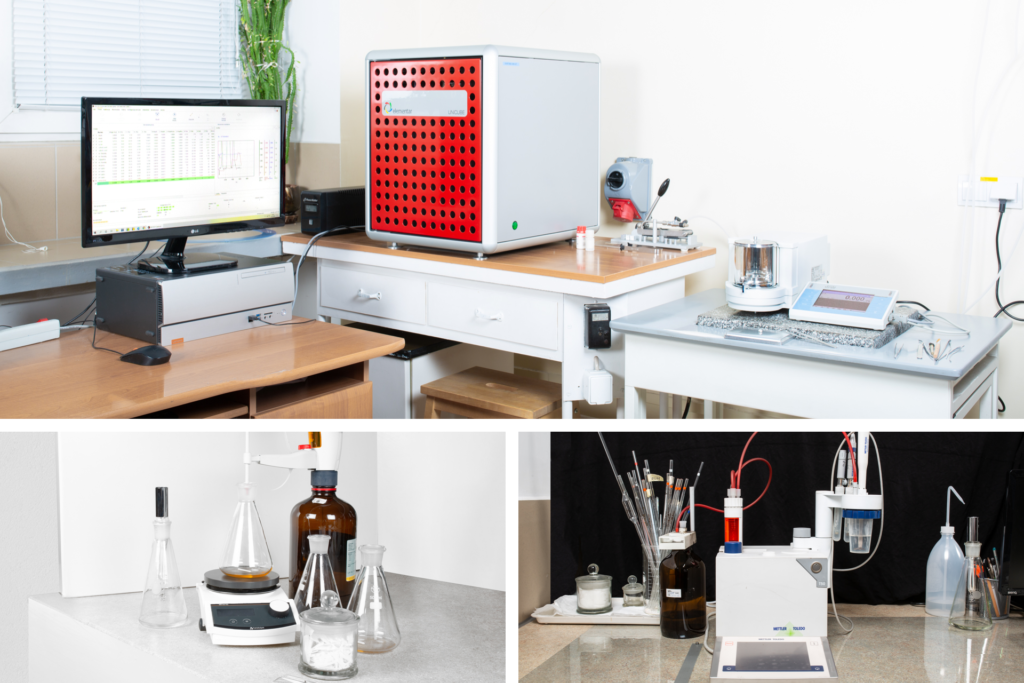Assoc. Prof. Wojciech Schilf
head of the Laboratory for Analysis of Bioactive Compounds
22 343 33 18
wojciech.schilf@icho.edu.pl
Laboratory for Analysis of Bioactive Compounds
Analytical offer of the Laboratory for Analysis of Bioactive Compounds
 |
- Confirmation of the identity and properties of the substance
The Laboratory for Analysis of Bioactive Compounds enables spectra measurements using all available techniques in individual Laboratories. The analyses are carried out in accordance with the requirements for registration and laboratory documentation.
We offer measurements using the following techniques:
- elementary analysis (AE)
- mass spectrometry (MS)
- nuclear magnetic resonance spectroscopy (NMR)
- optical and chiroptical spectroscopy (IR, UV-VIS-NIR, ECD, VCD, polarimetry, ORD)
- X-ray diffraction on monocrystals (X-ray).
Based on the measurement techniques selected by a client or proposed by us, we can confirm the identity of any organic substance.
- Preparation of comprehensive spectral documentation
The Laboratory for Analysis of Bioactive Compounds offers the service of preparing complete spectral documentation confirming the identity and purity of a chemical substance. Such documentation can be used during drug or chemical substances registration processes. It contains a set of spectra according to the list indicated by the client, along with a report including a description of the methodology and the interpretation of spectral data. Our Laboratory also has the option of including, e.g., DSC and XRPD measurements subcontracted to another entity in the documentation.
- Identification of contaminants in drugs and other substances
The Laboratory for Analysis of Bioactive Compounds carries out analyses to identify contaminants in drugs, cosmetics, plant protection products, and other products of the chemical industry based on chromatography techniques coupled with high-resolution mass spectrometry LC-MS and GC-MS. We have many years of experience in identifying structures based on advanced measurement techniques, both in the case of substances related to product ingredients and impurities of unknown origin. We perform analyses for samples from each production stage, from the synthesis substrates to the final and packaged product.
- Analysis of the composition of mixtures of organic compounds
The Laboratory for Analysis of Bioactive Compounds performs analyses of the composition of solid and liquid samples in terms of identification and content of organic compounds. After the initial consultation, the analytical technique is selected individually depending on the purpose and subject of the analysis.
- Qualitative and quantitative determination of organic compounds
The Laboratory for Analysis of Bioactive Compounds performs qualitative and quantitative determinations of organic compounds in various matrices using LC-MS and GC-MS techniques. We use advanced methods of substance isolation (e.g. SPME) and concentration of samples to determine substances in the range of very low concentrations.
- Manner of providing services
All analytical services are provided after the Laboratory for Analysis of Bioactive Compounds receives the following documents:
1. Cover letter – in this document, please specify the scope of ordered analytical services at the Laboratory for Analysis of Bioactive Compounds. The document must be signed by a person responsible for finances in a given institution or company, such as a director, dean, chief accountant, quaestor, or grant manager/holder (please provide the grant number). The hard copy or scan of the order should be sent to the head of the Laboratory responsible for the analysis (e-mail addresses are provided in the contact tab) or delivered
personally.
2. Order form (below) for each ordered sample; they contain the necessary information to correctly measure with the indicated technique (i.e., percentage composition, molar mass, chemical formula/ postulated structure, solubility, etc.).
3. Statement on acceptance of invoices sent electronically.
In the case of measurements covering the scope of one technique, inquiries should be sent to the head of a given Laboratory, and in the case of comprehensive analyses (exceeding the scope of services of one Laboratory), inquiries should be sent to the Comprehensive Analysis Laboratory at the following e-mail address: beata.naumczuk@icho.edu.pl.
For regular customers, it is possible to open a standing order for a given calendar year.
- Order execution time
Most standard measurements are performed within 2-3 working days. In the case of more complex analyses or plenty of samples all together, the execution time is agreed upon individually.
It is also possible to start scientific cooperation with the Laboratory for Analysis of Bioactive Compounds on the terms previously established and approved by the Director of the IOC PAS.
- To improve contacts between clients and analytical laboratories of the IOC PAS, we present below order forms for performing analysis:
Nuclear Magnetic Resonance Laboratory

Analytical service offer of NMR Laboratory in the Institute of Organic Chemistry PAS
The NMR Laboratory is a part of Laboratory of Bioactive Substances Analysis and is equipped with three spectrometers configured to liquid state measurements.
Spectrometer Varian-Agilent 600 MHz (model vnmrs) in standard condition is equipped with Auto XID probehead. This probehead has invers configuration which is excellent for all measurements with proton channel signal detection. The BB (broadband) channel of this probe covers spectral range from 31P to 15N (from 242.9 to 60.8 MHz). Now, we can offer to our customers the whole set of NMR measurements: 1D, 2D both homonuclear and heteronuclear correlation and diffusion experiments. The Auto XID probehead allows to run variable temperature experiments in -100 to 100℃ range. For this instrument we have also the Auto XDB probehead with direct configuration, which is very sensitive for heteronuclear direct measurements. This probe has the same spectral and variable temperature ranges as the Auto XID unit.
Spectrometer Varian-Agilent 500 MHz (model vnmrs). Usually, this instrument has installed the Auto XDB direct configuration probehead, which is recommended for direct (signal detection in BB channel) heteronuclear experiments. The variable temperature unit allows to achieve the -100 to 100℃ temperature range. The high frequency channel of this probehead can be used for fluorine spectra measurements. The BB channel covers spectral range from 31P to 15N (from 202.4 to 50.7 MHz). This probehead can be used also for invers correlation measurements, but it is not recommended because of significantly lower sensitivity of proton channel detection, comparing with Auto XID unit.
Spectrometer Bruker 400 (Avance III HD). This instrument is equipped with one universal probehead, which allows to measure both: experiments with proton (invers type) and BB channel (direct type) detection, without significant loss of sensitivity, comparing with dedicated probes. The broad band (BB) channel in this probe covers the spectral range from 19F to 109Ag (from 376.5 to 18.6 MHz), which provides possibility to acquire 1H – 19F correlations. The Bruker 400 instrument has the variable temperature facility working in -80 to 60℃ range without any cryogenic liquids and without any hardware reconfigurations.
All our spectrometers are connected to the internet system of the Institute and it is possible to transfer experiment results to user computers for data processing. Because of this we can use our instruments only for data acquisition, which make our work more efficient.
Varian-Agilent spectrometers are operated by our experienced operators, which can keep very high quality measurement level. All experiments are performed on the base of Measurement Order Form supplied together with the sample to the NMR Laboratory and results are saved on our server, where they are available for the customers. On request, we can supply the paper version of the spectra.
Spectrometer Bruker 400 is assigned to self-service operation. To operate this machine a short training and examination for new users are necessary. Self-service spectrometer is available seven days a week, 24 hours a day.
Dr. Wojciech Bocian
head of laboratory
22 343 25 52
wojciech.bocian@icho.edu.pl
Dr. Marta Bugaj-Zarębska
22 343 20 14
marta.bugaj@icho.edu.pl
Dr. Piotr Cmoch
22 343 25 52
piotr.cmoch@icho.edu.pl
M.Sc.Eng. Jerzy Sitkowski
22 343 25 52
jerzy.sitkowski@icho.edu.pl
Dr. Olga Staszewska-Krajewska
22 343 25 52
olga.staszewska@icho.edu.pl
M.Sc. Kamila Stępień
22 343 20 14
kamila.stepien@icho.edu.pl
M.Sc.Eng. Anna Tabaszewska
22 343 25 52
anna.tabaszewska@icho.edu.pl
Nuclear Magnetic Resonance Laboratory
(net price)
| measurement on a spectrometer: | price for non-commercial clients | price for commercial clients |
|---|---|---|
| 600 MHz | 120 PLN/hour. | 140 PLN/hour. |
| 500 MHz | 100 PLN/hour. | 110 PLN/hour. |
| 400 MHz | 50 PLN/hour. | |
| 200 MHz | 35 PLN/hour. |
For samples dissolved in CDCl3, DMSO-d6, D2O, benzene-d6 and acetone-d6, the cost of the solvent used is included in the price of the spectrum. For the remaining samples, the cost of the solvent used will be added to the price of the spectra in accordance with the following price list:
| solvent | price |
|---|---|
| acetonitrile-d3 | 9,30 PLN |
| dimethylformamide-d7 | 74,20 PLN |
| methanol-d4 | 13,80 PLN |
| dichloromethane-d2 | 14,00 PLN |
| pyridine-d5 | 13,90 PLN |
| toluene-d8 | 10,70 PLN |
| trifluoroacetic acid-d | 12,20 PLN |
The costs of other, non-standard solvents will be calculated based on the supplier’s current price lists.
Mass Spectrometry Laboratory

Mass Spectrometry Laboratory of the Institute of Organic Chemistry PAS for more than 20 years is delivering a high quality service in all branches of organic mass spectrometry. Cooperation with the synthetic organic chemistry research groups in our Institute, as well as large number of customers from other academic and industrial institutions resulted in thousands of samples per year our lab had to measure. The experience we gathered during this work allowed us to perform practically all types of MS analyses for organic compounds.
We offer measurements using ionization methods: ESI, APCI, ASAP. All measurements can be performed in low resolution and high resolution modes. We offer also GC-MS (together with identification of known compounds using NIST and Wiley databases) and LC-MS analyses. Our specialty are structural studies using MS/MS and MS3 fragmentation spectra, together with accurate mass measurements.
MaldiSYNAPT G2-S HDMS (Waters) coupled with ACQUITY UPLC I-Class System (Waters) ultra-performance liquid chromatography system.
Maldi SYNAPT G2-S HDMS spectrometer is the top model of the Waters QTOF-type machines. This is a hybrid QqTOF spectrometer with very sophisticated, three-part collision chamber. Central part of this chamber is used for the Ion Mobility Mass Spectrometry (IM-MS) technique. This unique method is based on the measurement of the drift times of ions in the chamber filled with collision gas. Drift times are then converted into collisional crossection values which can be related to the shape of the molecule. This makes possible distinguishing isomers and conformational studies in the gas phase. Time of flight mass analyzer makes possible accurate mass measurements for the ions and establishing their molecular formula with highcertainty. SYNAPT mass spectrometer can be coupled with UPLC Acquity (Waters) ultra-performance liquid chromatograph. SYNAPT is used for accurate mass measurements of pure samples and the samples separated by UPLC (accuracy better than 2 ppm) and for structural studies using collisional induced dissociation (CID) and ion mobility methods.
Basic parameters of the SYNAPT spectrometer:
- ESI, APCI, ASAP
- mass range: 40 – 8000 m/z
- resolvingpower: up to 40 000
Agilent 7890A & 5975CGC/MS system
The system consists of the Agilent 7890A gas chromatograph coupled with Agilent 5975C single quadrupole mass spectrometer with EI and CI ion sources. Gas chromatograph is equipped with an autosampler for 100 vials. Additionaly, samples can be introduced through the Headspace autosapmpler. Recorded spectra can be compared with NIST 08 mass spectral library. This system is used for routine GC/MS analyses.
Basic parameters:
- mass range: up to 1050 m/z
- max. oven temperature: 450 °C
Dr. Beata Naumczuk
head of laboratory
22 343 22 15
beata.naumczuk@icho.edu.pl
Dr. Zahra Badri
22 343 21 23
zahra.badri@icho.edu.pl
M.Sc. Ewa Gruba
22 343 22 10
22 343 22 11
ewa.gruba@icho.edu.pl
M.Sc. eng. Klara Nestorowicz
22 343 22 11
klara.nestorowicz@icho.edu.pl
Dr. Anna Osuch-Kwiatkowska
22 343 22 11
anna.osuch-kwiatkowska@icho.edu.pl
M.Sc. eng. Jakub Adam Sobel
22 343 22 11
jakub.sobel@icho.edu.pl
Dr. Dorota Staszek
22 343 21 23
dorota.staszek@icho.edu.pl
Mass Spectrometry
(net price)
| Direct MS | price for non-commercial clients | price for commercial clients |
| ESI measurement – low resolution spectrum (ESI-LR) | 110 PLN/sample | 140 PLN/sample |
| ESI measurement – high resolution spectrum (ESI-HR) | 200 PLN/sample | 250 PLN/sample |
| APCI measurement – low resolution spectrum (APCI-LR) | 110 PLN/sample | 140 PLN/sample |
| APCI measurement – high resolution spectrum (APCI-HR) | 200 PLN/sample | 240 PLN/sample |
| ASAP measurement – low resolution spectrum (ASAP-LR) | 110 PLN/sample | 140 PLN/sample |
| ASAP measurement – high resolution spectrum (ASAP-HR) | 200 PLN/sample | 250 PLN/sample |
| GC-MS | price for non-commercial clients | price for commercial clients |
| Sample preparation | 15-150 PLN | 20-200 PLN |
| Method development | 400 PLN | 500 PLN |
| Method transfer | 200 PLN | 250 PLN |
| GC-MS analysis | 120 PLN/sample | 160 PLN/sample |
| Interpretation of results | 150 PLN/h | 150 PLN/h |
| Report | 300-600 PLN | 400-800 PLN |
| LC-MS | price for non-commercial clients | price for commercial clients |
| Sample preparation | 15-150 PLN | 20-200 PLN |
| Method development | 800 PLN | 1000 PLN |
| Method transfer | 400 PLN | 500 PLN |
| HPLC-MS analysis | 400 PLN/sample | 500 PLN/sample |
| UPLC-HRMS analysis | 600 PLN/sample | 800 PLN/sample |
| Additional fragmentation spectra | from 300 PLN* | from 400 PLN* |
| Interpretation of results | 150 PLN/h | 150 PLN/h |
| Report | 300-600 PLN | 400-800 PLN |
| Calibration curve (5 points) for one substance | 1500 PLN | 2000 PLN |
* price determined individually; the price depends on the number of ions subjected to fragmentation
Laboratory of Optical Spectroscopy

The Laboratory of Optical Spectroscopy of the Institute of Organic Chemistry (Polish Academy of Sciences) for over 30 years has been dealing with measurements of organic compounds. Our unique blend of expertise and resources enables us to perform various chemical compounds professionally using the newest instruments for optical and chiroptical spectroscopies. We also help in matters related to selection of appropriate measurement methods/techniques.
UV-VIS-NIR spectroscopy encompasses the ultraviolet, visible and near-infrared region of the electromagnetic spectrum. This technique is routinely used for the qualitative and quantitative analysis of any chemical compounds containing in their structure chromophoric system.
Specialized equipment of the Laboratory of Optical Spectroscopy allows to analyze various samples in the range from 190 nm to 2700 nm using both the transmission and reflected methodologies, in solution and in solid phase.
Analytical capabilities
- qualitative and quantitative measurements in solution and solid-state;
- kinetics and temperature UV-VIS-NIR spectra.
Equipment
- Spectrophotometer UV-VIS-NIR Jasco V-670;
- Spectrophotometer UV-VIS Carry 100E.
IR spectroscopy allows analyzing the structure of molecules (and detect functional groups) and their interaction with the environment.
The Laboratory of Optical Spectroscopy carries out analytical services in the advanced generation of FTIR spectrometers and sampling accessories to analyze solids and liquids using transmission and reflectance (ATR) techniques.
Analytical capabilities
- IR measurements using transmission methods;
- IR measurements using ATR accessory (with diamond or ZnSe crystal);
- kinetics IR spectra.
Equipment
- Spectrophotometer FTIR Jasco 6200;
- Spectrophotometer FTIR Shimadzu IR Tracer-100.
Electronic Circular Dichroism (ECD) spectroscopy is a widely used method for determining the absolute structure of molecules in solution and solid-phase. It is a rapid, sensitive and reliable technique for determining 3D structure (not only configuration but also conformation), provided that the substance is chiral, non-racemic, and absorbs circularly polarized light in the available spectral range (180 – 1100 nm).
The Laboratory of Optical Spectroscopy is equipped with two modern ECD spectrometers with an extensive range of accessories and attachments that record the high-quality spectra for a wide range of chiral compounds. We also offer assistance in selecting appropriate chiroptical methods (ECD/ORD/VCD) to solve specific stereochemical problems appearing in the structural analysis of chiral compounds.
Analytical capabilities
- ECD measurements in solution and solid state;
- ECD temperature-dependent measurements within the range from +250 °C to -196 °C;
- ECD kinetics measurements;
- linear dichroism measurements (LD);
- measurements of protein with estimation of the secondary structure;
- HPLC separations with ECD detection with the possibility of recording a full ECD spectrum.
Equipment
- Spectropolarimeter ECD Jasco J-815;
- Peltier Cell Holder;
- Solid-state accessory for DTCD/DRCD;
- Automatic Titrator;
- Cryostat Optistat, Oxford Instruments;
- Thermostat Specac;
- Analytical HPLC set with typical chiral columns.
Optical Rotatory Dyspersion (ORD) spectroscopy/polarimetry is a technique complementary to the ECD, and it records the variation of optical rotation of chiral substances as a function of the wavelength of linearly polarized light. ORD spectroscopy is used in the analysis of optically active compounds, including no-absorbing systems. The application of ORD spectroscopy will facilitate stereochemical analysis of many chiral compounds that exhibit low values of specific rotation at 589 nm.
Analytical capabilities
- OR measurements at a selected wavelength(s) (standard 589 nm, other possibilities: 578, 546, 436, 405, 365 nm) at the constant temperature;
- ORD measurements in the range 200 – 850 nm at the constant temperature;
- variable temperature ORD measurements;
- kinetics ORD measurements.
Equipment
- Digital Polarimeter, Jasco P-2000;
- Spectropolarimeter ORD Jasco J-815;
- Peltier Cell Holder.
Vibrational Circular Dichroism (VCD) spectroscopy records the chiroptical spectra in the IR range. VCD can be regarded as an extension of ECD to the IR range, where the oscillatory transitions occur only within the ground-state of the molecule. The range of applications of VCD for structural studies of chiral substances is large. It is due to no need to have a chromophore in the molecule.
The Laboratory of Optical Spectroscopy is equipped with the latest generation of VCD spectrometer with the spectral range 4000 – 850 cm-1. The introduction of Dual Source and Dual PEM technology to VCD spectroscopy has opened new possibilities for the analysis of samples in the solid phase.
Analytical capabilities
- VCD measurements in solution and in solid-state.
Equipment
- ChiralIR-2XTM DualPEM BioTools spectrometer;
- rotary attachment.
Assoc. Prof. Marcin Górecki
head of laboratory
22 343 22 12
marcin.gorecki@icho.edu.pl
Dr. Anna Kamińska
22 343 22 12
anna.kaminska@icho.edu.pl
B.Sc. Ewa Zawistowska
22 343 22 14
ewa.zawistowska@icho.edu.pl
Alicja Dziedzic
22 343 22 14
alicja.dziedzic@icho.edu.pl
Optical Spectroscopy
(net price)
| price for non-commercial clients | price for commercial clients | |
| IR spectrum | 60 PLN/sample | 80 PLN/sample |
| VCD spectrum | 50 PLN/hour | 70 PLN/hour |
| UV-VIS-NIR spectrum | 80 PLN/hour | 100 PLN/hour |
| ECD spectrum | 100 PLN/hour | 120 PLN/hour |
| Temperature-dependent ECD measurements (Peltier Cell Holder; Cryostat Optistat) | 120 PLN/hour | 140 PLN/hour |
| HPLC analysis | 100 PLN/hour | 120 PLN/hour |
| HPLC-ECD analysis | 160 PLN/hour | 180 PLN/hour |
| ORD spectrum | 120 PLN/hour | 140 PLN/hour |
| Polarimetric measurement | 60 PLN/sample | 80 PLN/sample |
| Others types of measurements | price negotiable individually | price negotiable individually |
| type of analysis | price for non-commercial clients | price for commercial clients |
| Analysis of the IR spectrum with the similarity coefficient to the standard spectrum | 40 PLN/sample | 50 PLN/sample |
| IR spectrum analysis supported by the DFT calculations | 400 PLN/sample | 500 PLN/sample |
| Preparation of the final report | 150-800 PLN | 300-1000 PLN |
Laboratory of X-ray Structural Analysis

The X-Ray Diffraction Laboratory is equipped with modern Bruker AXS diffractometer with area detektor APEX II which allows for advanced X-ray diffraction characterization of monocrystalline organic and metalloorganic materials. Application of Cu-radiation is particularly useful in studies of small to medium size (10-500 atoms) organic molecules, including assignement of absolute configuration.
Low temperature device designed by Oxford Cryosystems provides opportunity to study structure and phase transitions in the 100 – 373 K temperature range.
Another availavle option is possibility of measurement of crystal size and face indexing that makes sit useful for some solid phase physiscs.
Optical microscope Nikon Eclipse E200 along with Linkam THMS 600 hot stage (up to 350 oC) and camera provides tolls for observation and registration of samples under the polarized light, following phase transition, growth of polymorphs, etc.
Assoc. Prof. Marcin Górecki
head of laboratory
48 22 343 22 07
marcin.gorecki@icho.edu.pl
Dr. Maja Morawiak
22 343 20 50 / 22 07
maja.morawiak@icho.edu.pl
X-ray Structural Analysis
(net price)
| price for non-commercial clients | price for commercial clients | |
| Measurement without calculations | 600 PLN/sample | 800 PLN/sample |
| Measurement and calculations | 1400 PLN/sample | 1600 PLN/sample |
| Nitrogen for measurement at low temperature | 50 PLN/ 60 l N2 | 50 PLN/ 60 l N2 |
Laboratory of Elementary Analysis

The Laboratory of Elementary Analysis is one of the oldest analytical laboratory at the IOC PAS. From the beginning of the Laboratory to the present days, we pride ourselves on the possibility of working on top-class devices, thanks to which we obtain precise results.
The analysis of the percentage of C, H, N, S content is performed in an automatic UNIcube analyzer by Elementarcompany. The basis of the measurement is the catalytic combustion of the analyzed substance at 1150 °C in the oxygen atmosphere. After cleaning of interfering gases (e.g. volatile chlorides), the combustion gases are separated on adsorption columns and determined successively by a thermal conductivity detector (TCD).
The analysis of the percentage of halogens and sulfuris determined mainly using the Schőniger method. After mineralization of the analyzed sample on the platinum catalyst in the flask filled with oxygen, the resulting ions are determined by titration:
- F – Schöniger method; titration with Th(NO3)4• 5H2Osolution
- Br – Schöniger method; titration with Hg(ClO4)2 solution
- S – Schöniger method; titration with Ba(ClO4)2 solution.
- Cl, I – potentiometric-argentometric method; titration with AgNO3 solution
At the customer’s request, we also carry out precise weights of small amounts of substances.
M.Sc. Krystyna Markucińska
head of laboratory
22 343 20 04
krystyna.markucinska@icho.edu.pl
M.Sc. Ewa Czykiel
22 343 20 04
ewa.czykiel@icho.edu.pl
Katarzyna Gwardiak
22 343 20 04
katarzyna.gwardiak@icho.edu.pl
Elementary Analysis
(net price)
| price for non-commercial clients | price for commercial clients |
|
| CH content | 130 PLN/sample | 140 PLN/sample |
| N content | 65 PLN/sample | 70 PLN/sample |
| XS content | 65 PLN/sample | 70 PLN/sample |
|
Preparation of the analytical weight |
10 PLN/sample | 10 PLN/sample |
Comprehensive Analysis Laboratory
The Comprehensive Analysis Laboratory deals with the analysis of organic substances requiring the use of several measurement techniques. We offer preparation of comprehensive documentation along with interpretation of analysis results, as well as provide consultation in the selection of appropriate methods and measurement techniques.
Dr. Beata Naumczuk
head of laboratory
22 343 22 15
beata.naumczuk@icho.edu.pl
Dr. Hanna Jędrzejewska
22 343 22 19
hanna.jedrzejewska@icho.edu.pl